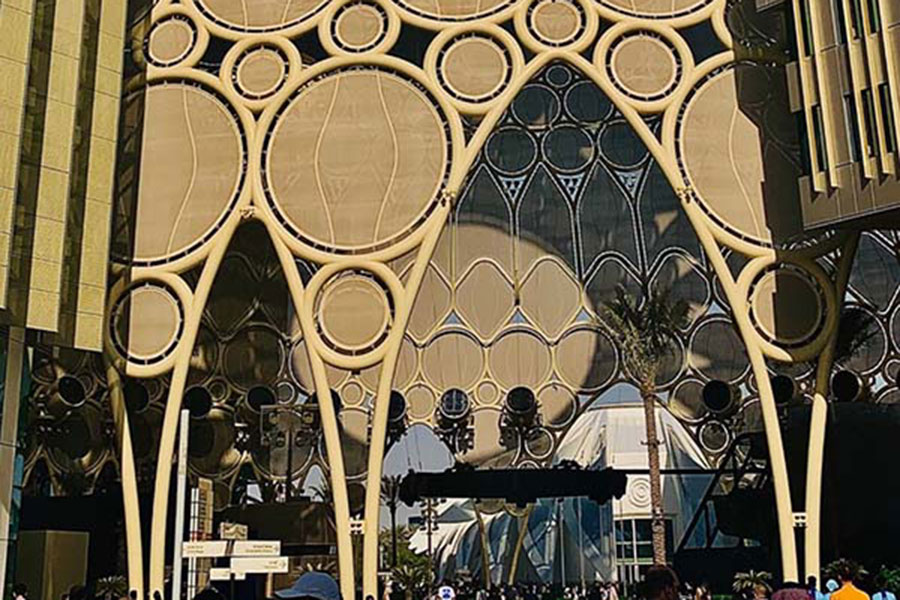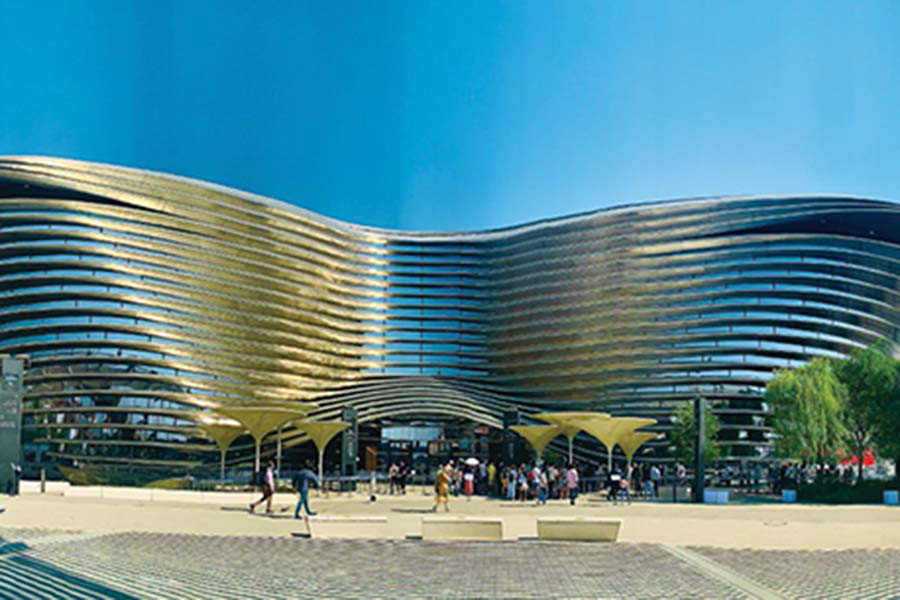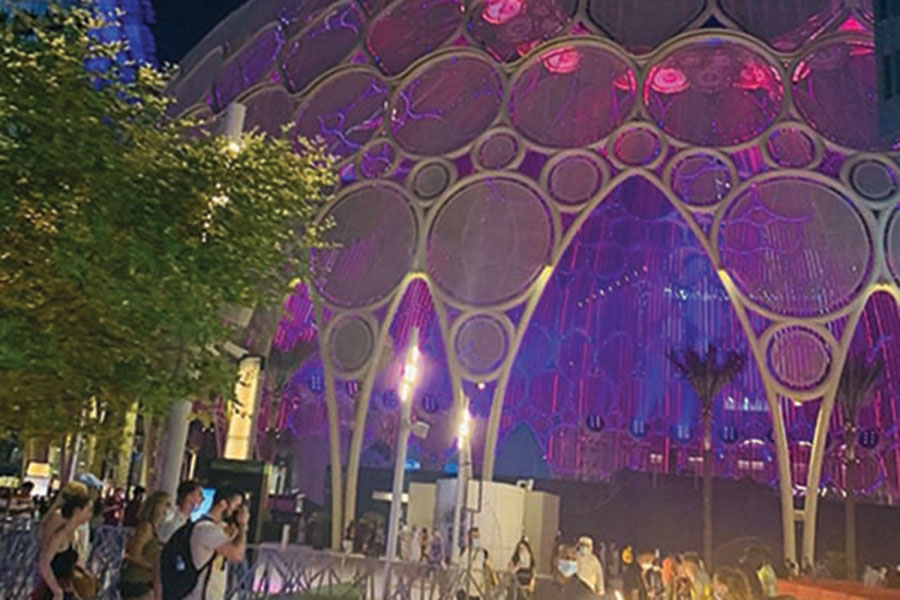When we think of Dubai, we think of innovation, inspiration, luxury. Expo 2020 Dubai is a mega event that embodies that spirit by showcasing creative initiatives from around the world, with architecture and design that inspires innovations and explores the power of connection.

This is the first time Expo has been held in the Middle East, North Africa and South Asia (MENASA). In 2013 the United Arab Emirates won the right to host the Expo in 2020, also as the first Arab country, but due to the Covid-19 outbreak the event was postponed to 2021. It is also the first time in World Expo history that every participating nation has had its own pavilion. World expos usually last six months and attract millions of visitors and hundreds of participants including nations, multilateral organisations and businesses. People from around the world visit the world of expo to explore the pavilions of the countries taking part, to discover their culture and enjoy events they organise.

The first World Expo was held in 1851 in the iconic Crystal Palace in London, to showcase the inventions of the Industrial Revolution. This year Expo is hosting 192 countries on a 4,38 thousand sq m area. The opening ceremony took place on 1 October. Expo 2020 will last till end of March, 2022. Dubai Expo demonstrates the country’s success in pioneering new paths to development and innovation. Dubai itself became a pioneer in every way because of its great achievements during the past few decades. Its high standing the world over inspired those in charge to make the theme of the event “Connecting Minds, Creating the Future”, with sub-themes such as “Mobility, Opportunity and Sustainability”, each represented in a separate pavilion alongside extraordinary architecture.

SUSTAINABILITY PAVILION: We are welcomed by Emirati dancers outside. The pavilion resembles flowers or leaves turned up towards the sun. The architecture is inspired by natural processes like photosynthesis, capturing energy from sunlight and fresh water from air humidity. The pavilion is surrounded by 19 “energy trees” that support photovoltaic arrays which provide more than a quarter of the energy needed to power the pavilion. The e-trees were designed as shades, so the building is completely a self-sufficient structure that combats the heat wave of Dubai. And, yes, it is significantly cooler inside.
Sustainability is explained as looking after our environment today so that people in the future can enjoy our wonderful world tomorrow. We dived under the ocean and wandered through the forest to learn more about the beauty of nature, humanity’s impact on the environment and how the choices we make today impact our future world.
Plants and animals adapt to change and live alongside each other in a balance humans too must be part of. As human beings we do many things that affect the balance of life all over the planet. Forests are being cut down, dangerous rubbish is building up, water is being used too carelessly and energy is being wasted. We were shown how to cause less damage to the planet, how to preserve the environment and how we might make a difference if we try to live responsibly.

ALIF MOBILITY PAVILION: Named after the first letter in the Arabic alphabet, Alif symbolises new beginnings and new ideas of mobility. We met Nour in complete darkness. She is humming and pointing to the sky. Is she reaching out to a friend or counting stars? Our journey begins from the dawn of civilisation. Human curiosity has fuelled our passion for exploration, discovery and invention: the passion for mobility.
We are welcomed to the study of philosopher, mathematician, physician and musician Abu Youssef Yaacoub Ibn Ishaq Al-Sabbah Al-Kindi at the 9th century Iraqi house of wisdom. It’s a journey through space and time. There we met three great travellers: Al-Bakri from Spain, Ibn Battuta from Morocco and Ibn Majed, known as the Lion of the Sea, from Ras Al-Kheima, UAE.
We also met several robots of the World Expo while wandering across its districts. Patrol robots, for example, protect and monitor the Expo site. They remind visitors of safe practices such as social distancing, and provide emergency announcements. I encountered one Patrol robot that told me, “Please wear face mask!”
Starting 29 October, free fitness sessions are being held at the Expo’s Sports, Fitness and Wellbeing Hub. The 30-minute sessions will last till 27 November, and attendance can be registered through the GloFox App.
Nor should the late-night life be missed. The Jubilee stage and the Millennium Amphitheatre of the Expo are always busy and colourful. The week we visited, international star Sami Yusuf dazzled the world with an exhilarating poetic performance that left the audience inspired. A few days later the Egyptian artist Abu took the stage, and this past weekend Egyptian mega-star Amr Diab fired the Jubilee Park.
Al Wasl – a digitally designed interpretation of the event’s logo, based on an ancient jewel recently discovered near the site – is an amazing dome located at the centre of the Expo. Its unique architecture, diverse range of installations, artistic sound and light take you to another world. When you pass the area during the day, the music played under the dome is mesmerising.
“This is the best piece of work of mine,” Gordon Gill, the architect behind the beating heart of the Expo, the iconic dome, told Al-Khaleej Times. “Not only adults, but even children’s jaws drop and eyebrows are raised every time they look at the plaza. It’s a feeling of ecstasy, awe, excitement and pride to see people holding their phones up for photos and selfies.” This is exactly what we were all doing. You felt the design of the dome is a connection between the sky, water, earth, air and human beings. Al Wasl, meaning “connection” in Arabic, is the historical name of Dubai which reflects the event’s aim: to bring people together under one roof.

The Expo 2020 Dubai organisers have hailed the first month of the event as a “huge success”, announcing an impressive 2,350 million visits from 1-31 October.
“So far, 28 per cent of visits were made by people under 18 years old, but this figure is expected to grow as the Expo School Programme expands during the cooler months ahead. Also 17 per cent of the total visits were from overseas, considering the event takes place when many countries are still operating pandemic travel restrictions. Expo has counted 185 nationalities through its gates, with the top five most popular overseas markets consisting of India, Germany, France, Saudi Arabia and the UK,” a Expo2020 Press Office statement said. “A total of 1938 government leaders, including ministers, presidents, prime ministers and heads of state, have visited the Expo site to open their country’s pavilions, speak at official events or celebrate their nation’s Expo National Day.”
EGYPT IN DUBAI: The celebration of the National Day of Egypt at Expo2020Dubai on 30 October was attended by Prime Minister Mustafa Madbouli, Sheikh Nahayan Mubarak Al Nahayan, UAE minister of tolerance and coexistence and commissioner general of the event.

The Egyptian pavilion is located in the Opportunity District. It receives its visitors with a unique architectural design that reflects Egypt’s position throughout the past, present and promising future. On the outside walls of the pavilion, visitors can see engraved hieroglyphic writings, an especially designed logo and a one minute 3D show. The logo is inspired by the Egyptian tradition that connects the Nile with the land. It is easy to read a translation of the design as “Egypt is the gift of the Nile”, the ancient Greek historian Herodotus’ famous saying. The entrance or the gate to the Egyptian pavilion is in the shape of a triangular glass pyramid.
The pavilion uncovers the story of the Egyptian human being, their past and present achievements. It offers a brief overview of a vision of a prosperous future of tourism, education and infrastructure.
The Egyptian pavilion is witnessing a huge turnout from all over the world. Standing in a queue, young and old men, women and children from UAE and other countries look excited to be witnessing the Egyptian experience. For some, this is the second visit since the opening of the Expo. “Mum, I can’t wait to see the Egyptian history we were taught at school inside this building,” I could hear one child saying.
Inside, all 3D shows are screened in an organised sequence. First you are welcomed in different languages by Aida, the virtual tour guide wearing pharaonic clothes. She continues to be your guide all through your journey, which includes Tourism 360, the Time Machine, Eye on Egypt, the coffin of Priest Psamtik, King Tut’s Golden Mask, the Grand Egyptian Museum, the Suez Canal, and finally Egypt’s new cities displaying the huge urban accomplishments and smart cities accomplished under President Abdel-Fattah Al-Sisi’s rule.
The priest Psamtik’s sarcophagus is the pavilion’s centrepiece and main attraction. Made of coloured wood, it was recently unearthed by an Egyptian archaeological mission in the Saqqara area of the Giza governorate. Also displayed on the first floor of the pavilion are replicas of King Tutankhamun, his golden mask and sarcophagus, his Ka-guard statue, the special occasions chair and the king’s golden throne. All these and promotional films shown on the walls of the pavilion aim to attract more tourists to Egypt, especially from Gulf states.
According to Ashraf Hamdi, the head of the Egyptian Commercial Office in Dubai and Egypt’s deputy commissioner-general to the Expo, traffic through the Egyptian pavilion is one of the highest compared to other Arab countries. “Sometimes we introduce entertainment shows to the visitors standing in line to make their time less boring, we also do that from time to time to attract Expo visitors to our pavilion in general.”
Hamdi and the Egyptian staff working for the pavilion do not aim for the highest number of visitors so long the pavilion is already receiving the maximum number allowed per day, based on the Covid rules at the Expo. “Only 40 visitors are allowed in the pavilion at any one round on weekdays, and we reach 150 on weekends. We are keen not to get Covid rule-breaking warnings from the Expo organisers. To be honest, the Egyptian pavilion receives 5,000-7,000 visitors a day.” Hamdi also said that one round of visits for 40 visitors usually takes 45 minutes inside the two-storey building. “If we were not in times of social distancing, the Egyptian pavilion would have had more than 10,000 visitors per day,” Hamdi told Al-Ahram Weekly.
Those young Egyptians receiving the pavilion visitors are of a high calibre. “I am proud to have 20 of them on the pavilion’s grounds. They are the second generation of the Egyptians living in the UAE and they were chosen from among 100 others who applied, according to a competition announcement we made during the preparations.” According to Hamdi some of them skipped university semesters, others left their jobs temporarily – unsure if they will be able to go back to them – just to join in organising the pavilion and representing their country at the Expo. “To me each one of them is an ambassador to Egypt, an honourable one. Those promising young Egyptians are also taking care of the pavilion pages on social media platforms in propagating Egypt at the Expo, they know a lot more than you and me, they are up to date, they have great minds and they work long hours. Those youths are the pride of the New Republic,” Hamdi told Egyptian reporters invited to Dubai to cover Expo2020 news.
The two-storey pavilion’s architecture and interior design is Egyptian-made. “As well as the makers of the footage of the 3D shows, all those who took part in making the pavilion a success are Egyptians, so we shouldn’t underestimate our manpower. Foreign visitors are fascinated by the huge achievement Egypt’s pavilion is up to,” the deputy commissioner-general to the Expo stressed.
Until the time of our visit Hamdi informed us that “the pavilion exceeded the 120,000 visitors since the opening.”
Jordanian senior reporter and editor Mohammad Kayyali, who was also on the tour, said, “The Egyptian pavilion takes you through time, in a dazzling visual style, where the Egyptian designers managed to make visitors feel they were living in ancient Egypt before moving to modern Egypt, one at a time.” Kayyali thinks the pavilion paints a beautiful picture of the largest Arab and African country. “It’s a beautiful feeling to see the Pharaohs of Egypt are so close to you, right beside you. Although I have never been to Egypt I felt I was a child of that ancient land, I was part of its history and its youthful people. Egypt excelled in its exhibition and dazzled thousand visitors,” Kayyali told the Weekly.
For his part Ashraf Hamdi praised the huge efforts the Egyptian ministries of tourism and antiquities exerted in making the Egyptian presence at the Expo a success. “It took us over two years to prepare for our participation at Dubai’s Expo,” he said.
The Egyptian pavilion also hosts several discussion events organised by almost all Egyptian ministries and authorities. “One of the events that has exceeded the number of registered participants is the Suez Canal Economic Zone (SCZONE) panel discussion. We will probably host it outside the pavilion for space reasons,” Hamdi explained. The event titled “Integrated Route-One Destination” which took place last week discussed investment opportunities and projects contracted in SCZONE, as Egypt’s new gateway for trade between East and West. SCZONE head Yehia Zaki, Suez Canal Authority Chairman and Managing Director Admiral Osama Rabie took part in the panel discussion.
“Haya Karima” or “Decent Life” is one of Egypt’s latest initiatives to provide adequate housing, infrastructure and living conditions in rural areas. The success of this initiative and how to localise Sustainable Development Goals (SDGs) among other communities were also discussed a couple of days ago at the Egyptian pavilion.
“Baheya… A Chanting for Peace” was a discussion that took place last week, about the experiences of Egyptian women in war and peace and the role a woman must play in defending her homeland and spreading a culture of peace for sustainable development. National Council for Women President Maya Morsy and journalist and board member of the council Nashwa Al-Hofi were among the panellists.
Only yesterday, Egypt’s pavilion hosted an event organised by the Ministries of Education and Higher Education. The panel discussed “Education in Egypt: from Kindergarten to the Job Market” in presence of both ministers Tarek Shawki and Khaled Abdel-Ghaffar.
In a lot of ways Egypt has become the talk of the world. At the end of every show there is huge applause. “I invite all Expo Dubai visitors to come and have a look first at Egypt’s pavilion, where they can get insights into ancient Egyptian civilisation and the methods used by Egyptian people throughout history to handle different life challenges,” said Sultan Faisal Al-Remeithi, secretary general of the Muslim Council of Elders, when he first visited the Egyptian pavilion.
The day Expo 2020 celebrated Egypt saw an unforgettable night of culture and entertainment. “Standing just metres away from the stage at the Amr Diab concert at Expo 2020 Dubai on Saturday, it is hard not to admire the star. Diab has proven time and time again that he is the Arab world’s king of pop, and this show was no exception. At 60, the Egyptian singer lives up to his nickname, Al-Hadaba – Arabic for “the hill”, given to him for the height of his fame, and that’s because Diab’s energy is, without a doubt, contagious,” was the UAE’s The National Art and Culture correspondent’s words about the mega star’s concert.
The Cairo Opera House Ballet Troupe also gave folk dance performances on the Egyptian Day.
MEET THE EGYPTIAN CHEF: Located at Al Wasl Plaza, “2020 Club Tower” by Emaar is an exquisite dining experience that serves international cuisine: breakfast, lunch, afternoon tea and dinner. The man behind the delicious food served at the restaurant is the 33-year old Egyptian chef Mohamed Suleiman. Suleiman has lived in Dubai for eight years now, he used to work for Emirates Airlines and is hoping to work for The Address Hotel in downtown Dubai after Expo 2020 comes to an end.
Suleiman is a graduate of Helwan University’s Faculty of Tourism and Hotel Management. “I have four cycles of menus for international food. Sometimes I get private functions for an Egyptian group or meeting at the restaurant, like the one I prepared two weeks ago when the Egyptian Minister of Transportation Kamel Al-Wazir was visiting the Expo.” Suleiman says you will find Egyptian food served only in particular areas in Dubai and at the Egyptian pavilion.
Before leaving Egypt Suleiman used to work for the Cairo Grand Hyatt (2005-2010), then he went to Saudi Arabia and Qatar before finally settling in Dubai, working for the same chain of hotels. Suleiman also worked for Jumeirah’s Borg Al-Arab, then joined Emaar.
He used to visit Egypt every six months before the outbreak of the pandemic. The Egyptian chef is married and has two daughters. His family used to live in Dubai but since the Covid-19 outbreak they have been back in Egypt. Suleiman hopes to visit Egypt soon to keep up with the government’s accomplishments, he says. “I am very concerned about the efforts to combat terrorism, and the policies the Egyptian government is taking for the security of the tourists visiting the country. Also one of my dreams had been to see a huge museum like the Grand Egyptian Museum opening soon at the heart of the Pyramids Plateau – I am happy it came true.”
Short link: